Abstract
Musculoskeletal problems have become a significant issue in the profession of dentistry. There are currently no recommended effective disease-preventing and modifying remedies. High prevalence rates for musculoskeletal disorders (MSDs) among dentists have been reported in the literature. Complementary and alternative medicine can be helpful in managing and preventing the MSDs. The purpose of this study was to determine if dentists in the western part of India are using complementary and alternative medicine therapies for MSDs, and also to find if those who use complementary and alternative medicine therapies have greater job/career satisfaction compared to conventional therapy (CT) users. Dentists of western India registered under the Dental Council of India (N = 2166) were recruited for the study. Data were analyzed using univariate and bivariate analyses and logistic regression. A response rate of 73% (n = 1581) was obtained, of which 79% (n = 1249) was suffering from MSDs. The use of complementary and alternative medicine or CT was reported by 90% (n = 1124) of dentists with MSDs. Dentists using complementary and alternative medicine reported greater health (P < 0.001) and carrier satisfaction (P < 0.001) and were able to work as many hours they wanted (P < 0.001) compared to CT users. Complementary and alternative medicine therapies may improve the quality of life and enhance job satisfaction for a dentist who suffers from MSDs.
Keywords: Complementary and alternative medicine, Dentist, Musculoskeletal disorders
INTRODUCTION
Dentistry is a mostly a social interaction between a dentist and the patient in their limited job setting and with personal characteristics. A healthy dentist is one of the most important components in a successful dental practice. Like all other professionals, dentists are exposed to occupational health hazards which predispose them to develop a multitude of health problems.[1] Maintaining the steady hand and posture by the dentist comes at a cost to the health of the dentist. High frequency of musculoskeletal disorders (MSDs) in dentists has been reported in the literature.[2,3,4] A recent review of the literature that examined the prevalence and risk factors of MSDs in dentists reported that the prevalence of general musculoskeletal pain in dental professionals ranges between 64% and 93%.[5] There are many factors that contribute to MSDs in dental professionals, including repetitive motion, pinch-grasp, vibration, force, and awkward positions, sitting for a long period of time, operator position, poor posture, lack of flexibility and strength, poor ergonomics, and insufficient work breaks.[6] It is generally agreed that the physical posture of the dentist should be relaxed while they work. Postures outside of this neutral position are likely to cause musculoskeletal discomfort.[7] Dentists can, and do, experience illnesses and problems that can disrupt or impair their practice. Many dentists have reported work stress caused by MSDs. Some have chosen to leave the profession because of their musculoskeletal pain.[8,9] Career and job satisfaction are the indicators that may have an influence on career longevity. Change in the work environment of the dentist might increase his/her career longevity. Complementary and alternative medicine (CAM), as defined by National Centre for Complementary and Alternative Medicine (NCCAM), is a group of diverse medical and health care systems, practices, and products that are not presently considered to be part of conventional medicine. The commonest reason for the use of CAM in the general population is pain. A large number of patients using CAM are those who suffer from chronic musculoskeletal pain. The cause of chronic pain is usually multifactorial and complex. Many studies have reported CAM therapies, including yoga, ayurveda, homeopathy, reiki, acupressure, massage, prayers, and acupuncture, to be effective in managing chronic musculoskeletal pain and other discomforts in the general population.[10,11,12,13,14]
There are currently no reports that link musculoskeletal pain, CAM, and career satisfaction among dentists working in western India. Since a large number of dentists all over the world report MSDs, this study was conducted in western India with an aim to determine if dentists are using CAM therapies to manage their MSDs and, if so, to determine if CAM therapies are associated with their job satisfaction and longevity, compared with conventional therapy users.
MATERIALS AND METHODS
The survey was conducted with the approval of the Institutional Review Board of Teerthankar Mahaveer University (TMU). Dentists registered under Indian Dental Association (IDA) were recruited to complete an 21-item questionnaire under 5 domains. A pilot study was conducted among dentists working in the Teerthankar Mahaveer Dental College and Research Centre. Following these pilot tests, the questionnaire was further modified and was uploaded on the web-based survey software. All dentists of western India who are current members of the IDA were recruited to participate. The final version of the questionnaire was formatted using web-based survey software for electronic distribution. Subjects were mailed the link to fill up the web-based questionnaire. This study included all registered dentists residing in western India with their e-mail addresses (N = 2166). Dentists were sent the link to their e-mail address for competing the survey. Dentists who participated in the pilot study, dental students, members of the general public, dental hygienists, dental assistants, and others who were not registered dentists were excluded. The questionnaire consisted of five domains: Demographic profile of the dentist, experience with musculoskeletal pain, use of conventional therapies or use of CAM therapies for its management, opinions about CAM and conventional therapies, and job/career satisfaction related to CAM.
Statistical analysis
Statistical analyses were conducted using SPSS 21. Univariate and bivariate analyses were performed to determine the demographic information, frequently reported areas of location of pain, the number of respondents that used CAM or conventional therapies, types of CAM or conventional therapies frequently used, work disruption caused by MSDs, and job satisfaction by using CAM and conventional therapies. Association between conventional therapy and CAM use in relation to career variables was assessed using Odds Ratio (OR). Independent samples t-tests were used to determine the opinions about CAM and conventional therapies for MSD management.
RESULTS
A total of 2166 survey e-mails were sent electronically, with a response rate of 73% (N = 1581). The nonrespondents were assumed to be similar to the respondents based on the notion that the group under study was somewhat a homogeneous group.
Findings of the demographic status of the dentists showed that a majority of the study population was males (75.7%) and worked primarily in their own private dental clinics (85.7%). A total of 79% (n = 1249) reported having MSDs, with the mean duration of pain being 8.3 years (median = 3.5). Other demographic characteristics of respondents are presented in Table 1. Frequent areas of location of pain in the body are depicted in Figure 1. Neck and lower back were the most common sites, followed by shoulders, upper back, wrist, elbow/arm, knee, hips, and legs.
Table 1.
Demographic characteristics of the dentists
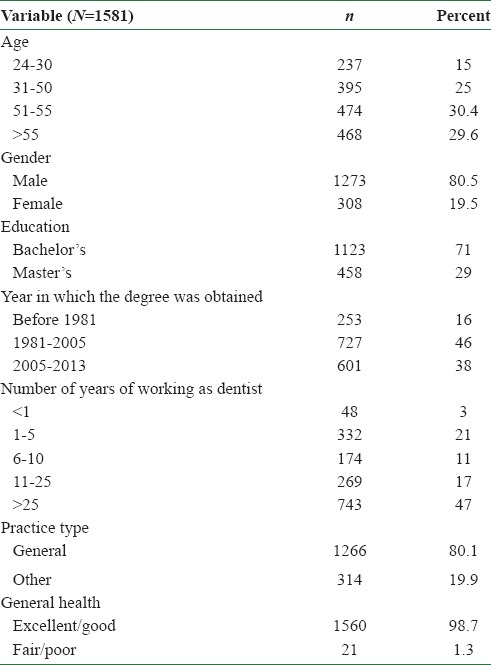
Figure 1.
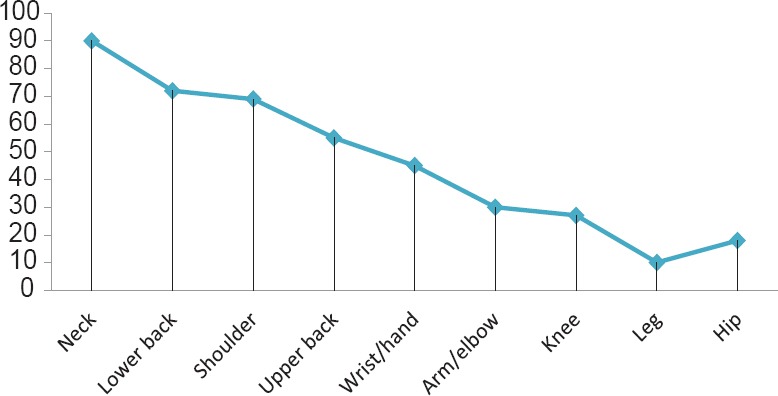
Percentage of dentist reported pain by location
Figure 2 shows work disruption among dentists as a result of MSDs. When comparison was made between individuals who used CAM therapies or conventional therapy alone and those individuals who used both CAM and conventional therapies, the latter group had 4 times lower odds of temporarily quitting work for longer than 1 month [OR = 3.4, 95% confidence interval (CI) =1.7-17.8].
Figure 2.
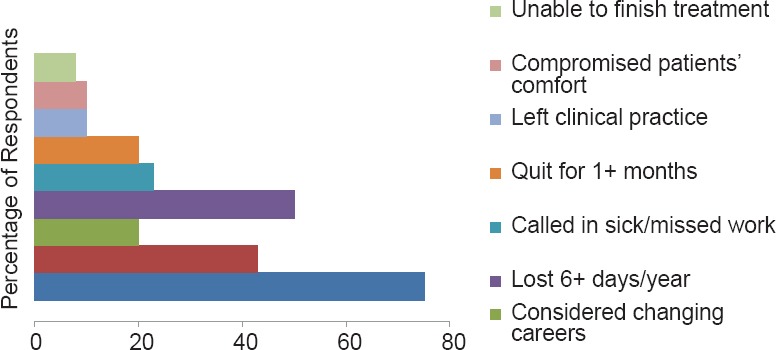
Work disruption among dentist due to MSD
Figure 3 depicts the use of CAM modalities by dentists. About 81% (n = 1012) dentists reported using both CAM and conventional therapies most frequently to manage MSDs. Also, of the 1249 individuals who reported MSDs, 31% (n = 388) used CAM therapies alone, 19% (n = 238) used conventional therapies alone, and 3% (n = 38) did not use any therapy. Dentists’ degree of pain improved significantly after using CAM therapies versus conventional therapies (P = 0.004). Dentists who suffered from musculoskeletal pain agreed 3 times more that CAM therapies were acceptable for MSD management (OR = 3.7, 95% CI = 2.7-3.9) than those with no pain, and were 3 times more likely to use CAM therapies for MSD management (OR = 3.4, 95% CI = 1.4-5.9). Table 2 depicts the job/career satisfaction among dentists who used CAM therapies and conventional therapies. Dentists who believed in CAM therapies and used them alone had significantly higher odds of agreeing that they were satisfied with their career as a dentist (OR = 3.2, 95% CI = 1.5-5.7) and that it contributed to career longevity (OR = 1.92, 95% CI = 1.4-7.3), increased overall health (OR = 1.67, 95% CI = 1.11-6.1), and improved the working efficiency (OR = 2.37, 95% CI = 1.1-7.3), and thus were satisfied with the job (OR = 1.51, 95% CI = 1.7-7.3) when compared to users of conventional therapies. Older dentists had significantly high rate of CAM usage than younger dentists (OR = 2.17, 95% CI = 1.157-1.007). Dentists who never used CAM reported poorer general health when compared to CAM users (OR = 1.16, 95% CI = 1.06-2.4). There were no statistically significant differences when controlling for race, type of degree earned, and number of years of practice.
Figure 3.
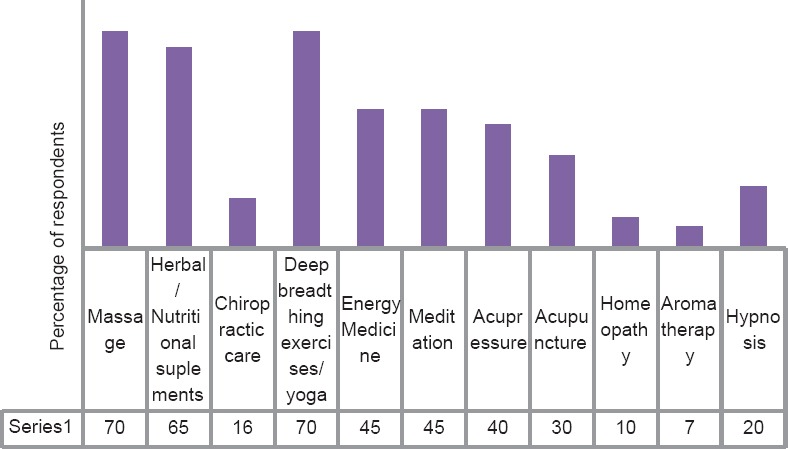
CAM use among dentist with MSD
Table 2.
Association between conventional therapy and CAM usage with job/career satisfaction
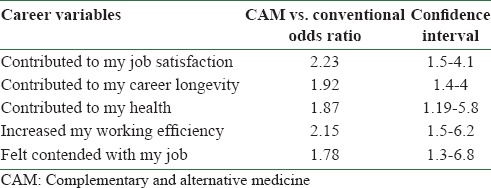
DISCUSSION
Recent studies have suggested that CAM usage is increasing worldwide.[15] Many different types of CAM therapies, including whole medical systems (homeopathic and naturopathic medicine), mind–body medicine (meditation, prayer, and mental healing), biologically based practices (ayurveda/herbal products), manipulative and body-based medicine (chiropractic care and massage), and energy medicine (reiki and therapeutic touch) are practiced worldwide. Many plants are used in various formulations such as decoctions, powders, medicated oils, paste, etc., for the treatment of MSDs either externally or internally. Ayurvedic drugs like Zingiber officinale, (生薑 Shēng Jiāng), Ricinus communis, Commiphora mukul, Boswellia serrata, Nyctanthes arbor-tristis, etc., are regularly used in the prescriptions for MSDs. Modern research scientists have conducted many scientific researches to assess the safety, efficacy, and anti-inflammatory potential of these drugs. Deep breathing exercises involve slow, deep breaths through the nose for 10 sec, followed by a complete exhalation for 10 sec for at least 5 cycles. Meditation is a practice in which an individual attempts to keep the mind clear and free from any other thoughts. It causes mental and physical relaxation. It helps individuals to deal with different problems. Chiropractic care deals by manipulation of joints and spine. Chiropractors act by adjusting the spine and sometimes by demonstrating exercises to the individuals. Massage therapist uses the technique of massage to adjust the muscles, which helps in relaxation. Massage is the commonest alternative therapy used for MSDs. Yoga is a combination of relaxation techniques and physical exercises. Yoga practitioners had less muscle weakness than compared to non practitioners.[10]. Acupuncture may also be sometimes used for treating MSDs. It involves using thin, metallic needles to penetrate the skin at different anatomical points of the body. There is extensive evidence that musculoskeletal pain is a significant burden in dentistry. Dental operators often cannot avoid prolonged static postures. Even in optimal seated postures, more than one-half of the body's muscles are contracted statically and there is little movement of the vertebral joints. This may result in damaging physiological changes that can lead to back, neck, or shoulder pain or MSDs.
The term “musculoskeletal disorder” is used to describe a wide range of injuries to the tendons, ligaments, nerves, and supporting structures. Chronic musculoskeletal pain appears after only a few years of clinical practice, or even during second or third year of undergraduate training.[16] Dentists are more prone to develop MSDs than any other professionals.[17,18,19] CAM therapies have been effective in reducing the risk of and treating musculoskeletal pain in the general population for several decades.[13] In our study, individuals who used CAM therapies alone were less likely to report temporarily quitting work. Therefore, a dentist who uses CAM therapies may reduce work interruptions caused by musculoskeletal pain. According to the present study, dentists who do not suffer from musculoskeletal pain experience higher job satisfaction when compared to those who suffer from MSDs (P = 0.001). Dentists who had MSDs reported negative impact on their career. Dentist using CAM therapies alone had greater career satisfaction compared to those who used conventional therapies alone. Therefore, dentists using CAM therapies for MSD management experienced higher satisfaction and longevity when compared to those using conventional therapies. The most favored CAM therapies among participants in the current study were massage, herbal supplements, and yogic exercises. The sample was predominantly male. Therefore, no effective gender comparison can be made. To date, no studies have examined the use of CAM for MSDs among dentists and its association with career satisfaction; therefore, the results of this study cannot be compared with any other similar study. Similar to other studies, our study also reported maximum musculoskeletal complaints in the neck and lower back region. Most of the dentists (81%) reported use of both CAM and conventional therapies in a complementary way for the treatment of musculoskeletal problems.
The hectic schedule of the dentists leaves them with no time to practice mind–body techniques and other CAM-related modalities to treat their musculoskeletal pain. Various researches have been conducted on the characteristics of CAM users and the determinants of CAM use. Some researches show that utilization of CAM is influenced by an individual's personality, family and friends, and socioeconomic factors such as race/culture, education, and economic level. There are scientifically proven direct links between lifestyle and herbs.[20,21,22,23,24,25,26] Yoga reduces stress and relieves muscular tension or pain. Dentists must practice some sort of exercise in their day-to-day routine, including yoga, to be relieved from the problem of musculoskeletal pain.
CONCLUSION
Dentists using CAM therapies reported they had greater overall health and more life satisfaction compared to conventional therapy users. CAM education should be incorporated in the dental curriculum to train the budding dentists about better management of MSDs. Education and additional research are needed to promote an understanding of the complexity of the problem and to address the problem's multifactorial nature. Dentist should adopt a holistic way of treating their musculoskeletal complaints. Knowledge and training of alternative therapies is very much required among professionals, especially dentists, so that they can use these therapies as a preventive and treatment modality for chronic pain emerging in day-to-day life and prolong their career.
ACKNOWLEDGMENT
Dr. Devanand Gupta would like to acknowledge my mentors Dr. D. J. Bhaskar and Dr. Mary Suvarna for their help and support and also to all the participants for their cooperation.
REFERENCES
- 1.Nermin Y. Musculoskeletal disorders (Msds) and dental practice: Part-1. General information terminology, aetiology, work-relatedness, magnitude of the problem and prevention. Int Dent J. 2006;56:359–66. doi: 10.1111/j.1875-595x.2006.tb00342.x. [DOI] [PubMed] [Google Scholar]
- 2.Murtomaa H, Haavio-Mannila E, Kandolin I. Burnout and its causes in Finnish dentists. Community Dent Oral Epidemiol. 1990;18:208–12. doi: 10.1111/j.1600-0528.1990.tb00059.x. [DOI] [PubMed] [Google Scholar]
- 3.Murtomaa H. Work related complaints of dentists and dental assistants. Int Arch Occup Environ Health. 1982;50:231–6. doi: 10.1007/BF00378085. [DOI] [PubMed] [Google Scholar]
- 4.Kajland A, Lindvall T, Nilsson T. Occupational medical aspects of the dental profession. Work Environ Health. 1974;11:100–7. [PubMed] [Google Scholar]
- 5.Rolander B, Bellner AL. Experience of musculo-skeletal disorders, intensity of pain, and general conditions in work-the case of employees in non-private dental clinics in a county in southern Sweden. Work. 2001;17:65–73. [PubMed] [Google Scholar]
- 6.Sanders MA, Turcotte CM. Strategies to reduce work-related musculoskeletal disorders in dental hygienists: Two case studies. J Hand Ther. 2002;15:363–74. doi: 10.1016/s0894-1130(02)80008-4. [DOI] [PubMed] [Google Scholar]
- 7.DeForge DH. Physical ergonomics in veterinary dentistry. J Vet Dent. 2002;19:196–200. doi: 10.1177/089875640201900402. [DOI] [PubMed] [Google Scholar]
- 8.Yamalik N. Musculoskeletal disorders (MSDs) and dental practice Part 2. Risk factors for dentistry, magnitude of the problem, prevention, and dental ergonomics. Int Dent J. 2007;57:45–54. doi: 10.1111/j.1875-595x.2007.tb00117.x. [DOI] [PubMed] [Google Scholar]
- 9.Saunders H, Saunders R. Vol. 1. Chaska, Minn: Educational Opportunities; 1995. Evaluations, treatment and prevention of musculoskeletal disorders; p. 7. [Google Scholar]
- 10.Williams K, Abildso C, Steinberg L, Doyle E, Epstein B, Smith D, et al. Evaluation of the effectiveness and efficacy of iyengar yoga therapy on chronic low back pain. Spine. 2009;34:2066–76. doi: 10.1097/BRS.0b013e3181b315cc. [DOI] [PMC free article] [PubMed] [Google Scholar]
- 11.Marshall ED, Duncombe LM, Robinson RQ, Kilbreath SL. Musculoskeletal symptoms in New South Wales dentists. Aust Dent J. 1997;42:240–6. doi: 10.1111/j.1834-7819.1997.tb00128.x. [DOI] [PubMed] [Google Scholar]
- 12.Sherman KJ, Cherkin DC, Erro J, Miglioretti DL, Deyo RA. Comparing yoga, exercise, and a self. care book for chronic low back pain: A randomized, controlled trial. Ann Intern Med. 2005;143:849–56. doi: 10.7326/0003-4819-143-12-200512200-00003. [DOI] [PubMed] [Google Scholar]
- 13.Brinkhaus B, Witt CM, Jena S, Linde K, Streng A, Wagenpfeil S, et al. Acupuncture in patients with chronic low back pain: A randomized controlled trial. Arch Intern Med. 2006;166:450–7. doi: 10.1001/archinte.166.4.450. [DOI] [PubMed] [Google Scholar]
- 14.Fautrel B, Adam V, St-Pierre Y, Joseph L, Clarke AE, Penrod JR. Use of complementary and alternative therapies by patients self-reporting arthritis or rheumatism: Results from a nationwide Canadian survey. J Rheumatol. 2002;29:2435–41. [PubMed] [Google Scholar]
- 15.Hayes MJ, Smith DR, Cockrell D. Prevalence and correlates of musculoskeletal disorders among Australian dental hygiene students. Int J Dent Hyg. 2009;7:176–81. doi: 10.1111/j.1601-5037.2009.00370.x. [DOI] [PubMed] [Google Scholar]
- 16.Abou-Atme YS, Melis M, Zawawi KH, Cottogno L. Five-year follow-up of temporomandibular disorders and other musculoskeletal symptoms in dental students. Minerva Stomatol. 2007;56:603–9. [PubMed] [Google Scholar]
- 17.Dajpratham P, Ploypetch T, Kiattavorncharoen S, Boonsiriseth K. Prevalence and associated factors of musculoskeletal pain among the dental personnel in a dental school. J Med Assoc Thai. 2010;93:714–21. [PubMed] [Google Scholar]
- 18.Thornton LJ, Barr AE, Stuart-Buttle C, Gaughan JP, Wilson ER, Jackson AD, et al. Perceived musculoskeletal symptoms among dental students in the clinic environment. Ergonomics. 2008;51:573–86. doi: 10.1080/00140130701728277. [DOI] [PubMed] [Google Scholar]
- 19.Honda K, Jacobson JS. Use of complementary and alternative medicine among United States adults: The influences of personality, coping strategies, and social support. Prev Med. 2005;40:46–53. doi: 10.1016/j.ypmed.2004.05.001. [DOI] [PubMed] [Google Scholar]
- 20.Gupta D, Bhaskar DJ, Gupta RK, Karim B, Gupta V, et al. Effect of Terminalia chebula Extract and Chlorhexidine on Salivary pH and Periodontal Health: 2 Weeks Randomized Control Trial. Phytotherapy Research. 2014;287:992–8. doi: 10.1002/ptr.5075. [DOI] [PubMed] [Google Scholar]
- 21.Karim B, Bhaskar D.J, Agali A, Gupta D, Gupta RK, Jain A, kanwar A. Effect of Aloe vera Mouthwash on Periodontal Health: Triple Blind Randomized Control Trial. Oral Health Dent Manag. 2014;13:14–9. [PubMed] [Google Scholar]
- 22.Gupta Rajendra Kumar, Gupta Devanand, Bhaskar Dara John, Yadav Ankit, Obaid Khursheed, Mishra Sumit. Preliminary antiplaque efficacy of aloe vera mouthwash on 4 day plaque re-growth model: Randomized control trial. Ethiop J Health Sci. 2014;24:139–44. doi: 10.4314/ejhs.v24i2.6. [DOI] [PMC free article] [PubMed] [Google Scholar]
- 23.Devanand G, John BD, Rajendra GK, Bushra K, Alpana K, Ankita J, et al. Use of complementary and alternative medicine for work related musculoskeletal disorders associated with job contentment in dental professionals: Indian outlook. Ethiopian Journal of Health Sciences. 2014;24:117–24. doi: 10.4314/ejhs.v24i2.3. [DOI] [PMC free article] [PubMed] [Google Scholar]
- 24.Gupta DA, Bhaskar DJ, Gupta RK. Germany: Lap Lambert Academic Publishing; 2013. Contemporary and alternative dentistry: Ayurveda in dentistry. [Google Scholar]
- 25.Gupta D, Bhaskar DJ, Gupta RK, Jain A, Yadav P, Dalai DR, et al. Is CAM therapy effective in job satisfaction among dentist with Musculoskeletal Disorders: A cross sectional Study. Medycyna Pracy. 2014;65:317–23. [PubMed] [Google Scholar]
- 26.Gupta D, Bhaskar DJ, Gupta RK, Karim B, Jain A, Singh R, et al. A randomized controlled clinical trial of Ocimum sanctum and chlorhexidine mouthwash on dental plaque and gingival inflammation. Journal of Ayurveda and Integrative Medicine. 2014;5:109–16. doi: 10.4103/0975-9476.131727. [DOI] [PMC free article] [PubMed] [Google Scholar]


